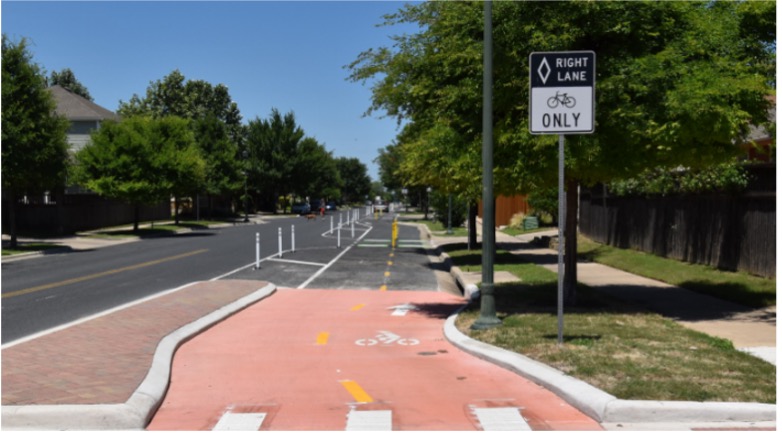This case study is part of the Federal Highway Administration toolkit on innovative finance strategies to accelerate bicycle and pedestrian project delivery, a reference for local and state transportation agencies. Austin Mobility Bonds have provided millions of dollars for active transportation projects, including a bikeway on Zach Scott Street in Austin, Texas.

The City of Austin has a long history of using general obligation bonds for transportation investments. Starting in 1996, community members and advocacy groups helped build support to pass several transportation bond packages. These bond packages helped finance projects focused on mobility, including road, sidewalk, and trail improvements. While previous bonds also supported active transportation, the 2016 and 2020 bonds significantly increased the amount allocated to active transportation. The 2016 Bikeways program helped support Austin’s goal of completing 50 percent of the All Ages and Abilities Bicycle Network by 2020. The 2020 Bikeways program designated $40 million to complete 70 percent of this network.In 2016 and 2020, voters in Austin, Texas approved bond packages that designated millions for active transportation. The 2016 bond was a $720 million package that set aside $20 million specifically for bikeways. Other programs funded through the bond include Sidewalks ($37.5 million), Safe Routes to School ($27.5 million), and Urban Trails ($26 million), as well as major Regional Mobility projects and Corridor Improvement projects. Many of these programs can also support bike and pedestrian projects. The 2020 bond is a $460 million package primarily focused on active transportation that sets aside $40 million for bikeways, as well as $80 million for Sidewalks, $80 million for Urban Trails, and several other programs.
Projects constructed with 2016 Mobility Bond revenues must fulfill the “Contract with Voters” (City Council Resolution 20160818-047). This resolution specifies the types of projects that can use bond funding as well as the processes for implementing each program. For example, Corridor Improvement projects must prioritize reducing congestion, improving level of service, and enhancing connectivity and effectiveness of transit operations. Bikeway funding is specifically for transportation and mobility purposes. Bikeway projects come from the Austin Bicycle Plan and the Austin Strategic Mobility Plan, the central plan guiding mobility investments in Austin for the next 20 years. The development of this plan included an extensive public engagement process.
The 2016 Mobility Bond has already supported many projects, including a 0.7 two-way protected bikeway Zach Scott Street and Schieffer Avenue. This project improved bicycle and pedestrian mobility, safety, and connectivity. It also included new protected intersections, a new bicycle signal, and a new pedestrian crossing. The bikeway improves connectivity to Maplewood Elementary School and Patterson Neighborhood Park.

Funding for the Zach Scott Street and Schieffer Avenue project came from three different programs of the Mobility Bond: Bikeways, Safe Routes to School, and Sidewalks.
The City significantly reduced project costs by coordinating with resurfacing efforts. By coordinating these efforts, bikeway costs associated with resurfacing were estimated to be a tenth of the cost of a stand-alone project. Advocates and City staff worked with the developer of an adjacent mixed used project to create a two-way protected bike lane in front of the development. While resurfacing Zach Scott Street, the City was able to extend this protected bikeway.
Because the bikeway is near Maplewood Elementary School, the Safe Routes to School program staff also identified the need for safety improvements in this corridor. Eligible Safe Routes funding helped construct a connection from Schieffer Avenue to Maplewood Elementary.
The City of Austin uses a rotating list for field engineering to help accelerate the construction process. The City develops a schematic-level design and then partners the field engineers to obtain services with the concrete contractor (under an indefinite delivery, indefinite quantity (IDIQ) contract) to deliver the project efficiently and effectively following a public involvement process.
The Austin Strategic Mobility Plan, the City’s strong public engagement processes, and leadership support were key to delivering this project as well as other bond projects. Community members voiced concerns about speeding on Zach Scott Street and about the effect of the project on parking. Through the public engagement process, the City created a design that addressed parking concerns, prioritized safety, and addressed access needs for emergency vehicles.
Access to Mobility Bond funding helped the project move quickly. In 2018, the City of Austin began preparing for the resurfacing project on Zach Scott Street. The City held a public meeting in August 2018 about opportunities to enhance the bicycle and pedestrian facilities as a part of the resurfacing effort. Less than a year later, the City completed the project.
As of December 2019, the 2016 Mobility Bond funded over 200 completed active transportation projects. Completed projects include 19 bikeway projects, 40 Safe Routes to School Projects, 7 urban trail projects, 130 sidewalk projects, and other bicycle and pedestrian infrastructure improvements. The City held a ribbon-cutting ceremony for the Zach Scott Street and Schieffer Avenue project in 2019.
This facility now connects Maplewood Elementary School, multiple parks, grocery stores, and a farmers’ market.
Laura Dierenfield
Active Transportation Program Manager, City of Austin
(512) 974-7189
laura.dierenfield@austintexas.gov
901 S. MoPac Expressway, Building 5, Suite 300
Austin, TX 78746
City of Austin. 2016. “City Council’s Contract with Voters.”
City of Austin. 2017. “2016 Mobility Bond Program Overview and Implementation Plan.”
City of Austin. 2020. “2016 Bond Three Year Progress Report.”
City of Austin. 2020. “https://austintexas.gov/2020PropB.”
City of Austin. N.d. “Zach Scott Street and Schieffer Avenue.”
City of Austin.